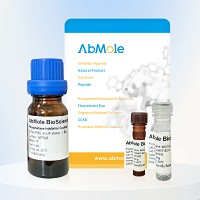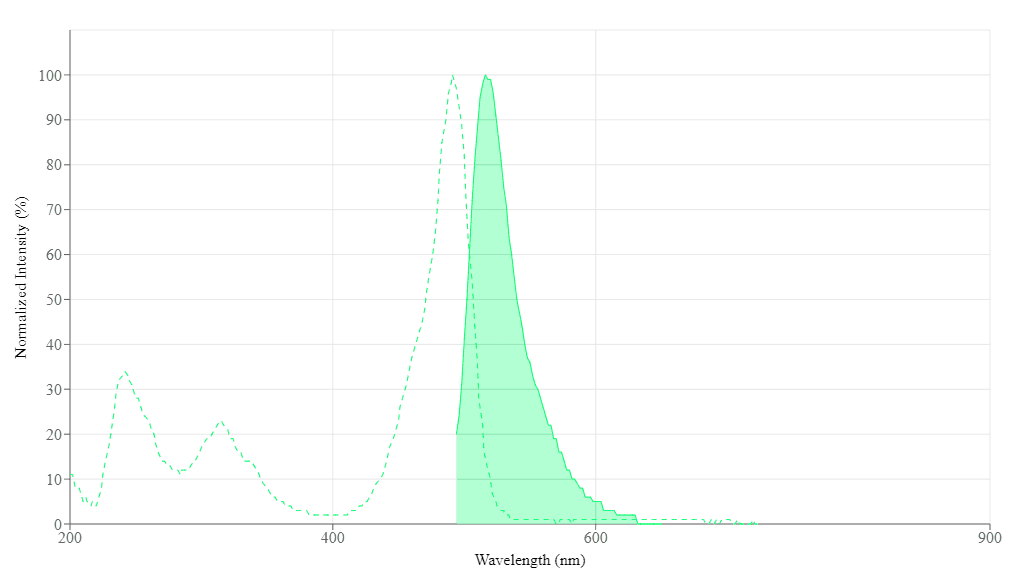All AbMole products are for research use only, cannot be used for human consumption.

Phalloidin-iFluor 488 Conjugate selectively binds to F-actins with much higher photostability than the fluorescein-phalloidin conjugates.
Ex (nm) 491, Em (nm) 516.
Phalloidin binds to actin filaments much more tightly than to actin monomers, leading to a decrease in the rate constant for the dissociation of actin subunits from filament ends, essentially stabilizing actin filaments through the prevention of filament depolymerization. Moreover, phalloidin is found to inhibit the ATP hydrolysis activity of F-actin. Phalloidin functions differently at various concentrations in cells. When introduced into the cytoplasm at low concentrations, phalloidin recruits the less polymerized forms of cytoplasmic actin as well as filamin into stable "islands" of aggregated actin polymers, yet it does not interfere with stress fibers, i.e. thick bundles of microfilaments. The property of phalloidin is a useful tool for investigating the distribution of F-actin in cells by labeling phalloidin with fluorescent analogs and using them to stain actin filaments for light microscopy. Fluorescent derivatives of phalloidin have turned out to be enormously useful in localizing actin filaments in living or fixed cells as well as for visualizing individual actin filaments in vitro. Fluorescent phalloidin derivatives have been used as an important tool in the study of actin networks at high resolution.

| Solubility (25°C) | DMSO |
| Storage | -20°C, protect from light, sealed |
| Related Fluorescent Dye Products |
|---|
| PGSK diacetate (5/6-mixture)
PGSK diacetate (5/6-mixture) is a metal ion-sensitive fluorescent probe that can penetrate cell membranes. PGSK diacetate can react with a variety of metal ions, including Fe2+, Cd2+, Co2+, Ni2+, Zn2+, etc. PGSK diacetate chelates Fe2+, resulting in fluorescence quenching, which can be restored when a membrane-permeable chelator is added, thereby reflecting the changes in the intracellular chelatable iron pool. The excitation/emission maxima of PGSK diacetate are 507/532 nm, respectively. |
| Dextran-Rhodamine B
Dextran-Rhodamine B (RB-Dextran) is a fluorescent marker made by combining rhodamine B fluorescent dye and dextran polysaccharide through a specific chemical reaction. RB-Dextran is a red fluorescent modified dextran polysaccharide formed by chemically labeling rhodamine B onto dextran molecules, which can be used in cell tracing, biofluid dynamics research and other fields, and its fluorescent properties can be used to track the distribution and metabolism of dextran in organisms and other processes. |
| N-Succinimidyl 6-(2,4-Dinitroanilino)hexanoate
N-Succinimidyl 6-(2,4-Dinitroanilino)hexanoate, the DNP-X acid modified by succinimidyl ester, is an amine-reactive building block for developing a probe, which can be recognized by anti-DNP antibodies. |
| FITC-Arachidonic Acid
FITC-Arachidonic Acid is a fluorescent labelled compound for biomedical research. FITC-Arachidonic Acid combines the biological activity of arachidonic acid and the fluorescent properties of FITC, and is suitable for the study of cellular signalling, lipid metabolism and so on. |
| Arachidonic acid-biotin
Arachidonic acid-Biotin is a biotin-labeled Arachidonic acid that can be used to detect complexes of arachidonic acid with protein binding partners such as fatty acid binding proteins (FABPs). |
All AbMole products are for research use only, cannot be used for human consumption or veterinary use. We do not provide products or services to individuals. Please comply with the intended use and do not use AbMole products for any other purpose.


Products are for research use only. Not for human use. We do not sell to patients.
© Copyright 2010-2024 AbMole BioScience. All Rights Reserved.
